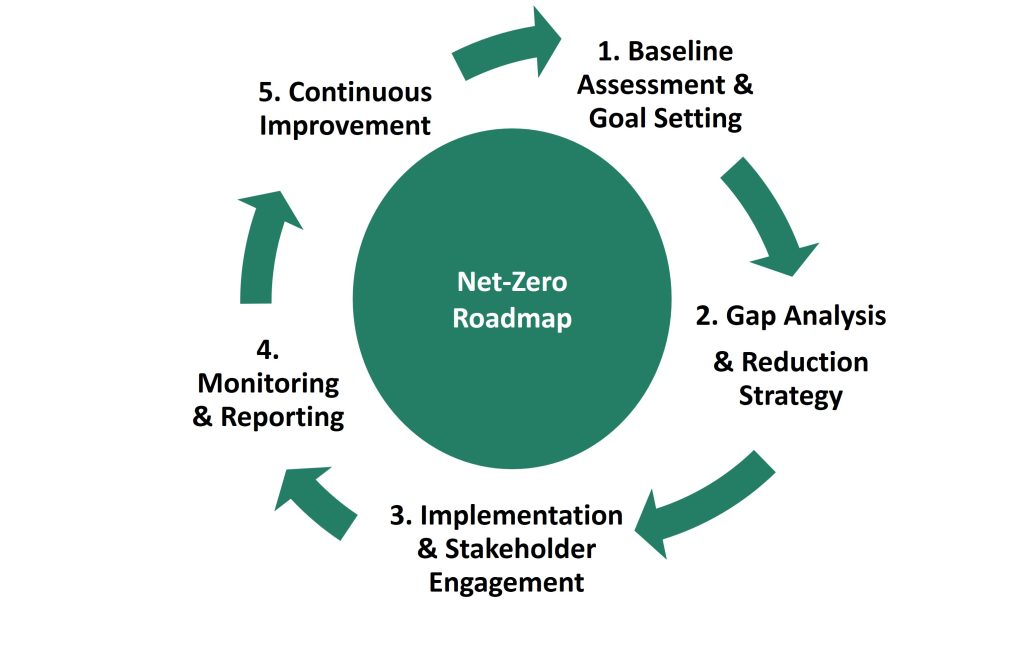Net-Zero Roadmap

xESG’s net-zero roadmap offering guides businesses of all sizes and sectors towards carbon neutrality and sustainability. Our structured approach, aligned with regulatory guidelines and reputable initiatives, drives efficiency, resilience, and innovation. Through assessment, strategy development, stakeholder engagement, and continuous improvement, we empower clients to achieve tangible value while advancing their environmental goals.
Why Does it Matter?
A net-zero roadmap serves as a strategic blueprint for transitioning your organization towards carbon neutrality and environmental sustainability. By setting clear targets and outlining actionable steps, a well-crafted net-zero roadmap can help your company:
Enhance Operational Efficiency: Identify and implement measures to reduce energy consumption, minimize waste, and optimize resource use, leading to cost savings and improved productivity.
Mitigate Risks: Anticipate and address climate-related risks such as regulatory changes, supply chain disruptions, and reputational damage, safeguarding your business against future uncertainties.
Enhance Brand Reputation: Demonstrate your commitment to sustainability and attract environmentally-conscious customers, investors, and talent, enhancing brand loyalty and stakeholder trust.
Drive Innovation: Stimulate innovation and market differentiation by investing in sustainable technologies, products, and business models that meet evolving consumer preferences and regulatory requirements.
Future-Proof Your Business: Position your company for long-term resilience and competitiveness in a rapidly changing business landscape shaped by climate change, resource scarcity, and shifting societal expectations.
Our Approach
At xESG, we follow a structured approach to develop and implement net-zero roadmaps tailored to the unique needs and circumstances of each client. Our process is guided by regulatory guidelines applicable to our clients’ industries, as well as best practices from reputable net-zero initiatives such as TCFD (Task Force on Climate-related Financial Disclosures) and SBTi (Science Based Targets initiative). It typically includes the following steps:

1. Baseline Assessment & Goal Setting: Conduct a comprehensive assessment of your organization’s current emissions profile, sustainability practices, and strategic objectives. Collaboratively define ambitious yet achievable net-zero targets aligned with your business goals.
2. Gap Analysis & Reduction Strategy: Identify key emissions sources and opportunities for reduction across your operations, supply chain, and value chain. Develop a customized roadmap with a suite of mitigation measures (aka key emissions reduction levers), including energy efficiency improvements, renewable energy adoption, waste reduction strategies, and carbon offsetting options.
3. Execution – Stakeholder Engagement & Implementation: Develop an implementation plan with clear timelines, responsibilities, and performance metrics to track progress towards net-zero goals. Engage stakeholders across your organization, including employees, suppliers, customers, and investors, to foster buy-in and alignment with the net-zero vision.
4. Monitoring & Reporting: Establish robust monitoring and reporting mechanisms to track the implementation of emissions reduction levers, measure progress towards net-zero targets, and transparently communicate outcomes to stakeholders.
5. Continuous Improvement: Continuously evaluate the effectiveness of strategies, identify areas for improvement, and adapt the roadmap accordingly to stay on track towards achieving net-zero emissions.
